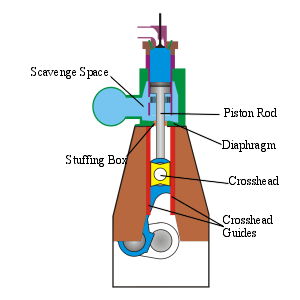2stroke crosshead engines
The disadvantages of the two stroke trunk piston engine are that although it has a low overall height, lubricating oil splashed up from the crankcase to lubricate the liner can find its way into the scavenge space, causing fouling and a risk of fire. There is also the likelihood of liner and piston skirt wear, allowing air into the crankcase. This can supply the required oxygen for an explosion should a hot spot develop. The crankcase oil must have additives which can cope with contamination from products of combustion, and the acids formed during combustion due to the sulphur in the fuel.
| The majority of 2 stroke engines encountered at sea are of the "crosshead" type. In this type of engine the combustion space (formed by the cylinder liner, piston and cylinder head), and the scavenge space are separated from the crankcase by the diaphragm plate. The piston rod is bolted to the piston and passes through a stuffing box mounted in the diaphragm plate. The stuffing box provides a seal between the two spaces, stopping oil from being carried up to the scavenge space, and scavenge air leaking into the crankcase. The foot of the piston rod is bolted to the crosshead pin. The top end of the connecting rod swings about the cosshead pin, as the downward load from the expanding gas applies a turning force to the crankshaft. To ensure that the crosshead reciprocates in alignment with the piston in the cylinder, guide shoes are attached either side of the crosshead pin. These shoes are lined with white metal, a bearing material and they reciprocate against the crosshead guides, which are bolted to the frame of the engine. The crosshead guides are located inbetween each cylinder. Using the crosshead design of engine allows engines to be built with very long strokes - which means the engine can burn a greater quantity of fuel/stroke and develop more power. The fuel used can be of a lower grade than that used in a trunk piston engine, with a higher sulphur content, whilst high alkalinity cylinder oils with a different specification to that of the crankcase oil are used to lubricate the cylinder liner and piston rings and combat the effects of acid attack. |
The most powerful diesel engines in the world are two stroke crosshead engines. Some of these engines have cylinder bores approaching 1metre with a stroke of over 2.5 metres. The crankshaft can weigh over 300 tons, with the engine weighing in excess of 2000 tons





Comments
Post a Comment